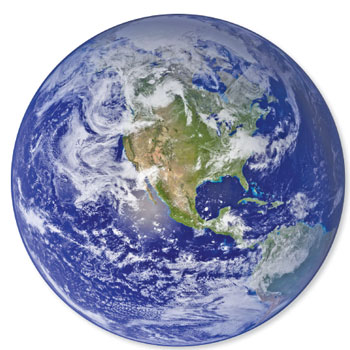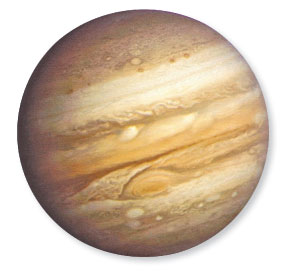Earth, our home planet
Earth, our home planet, is the only planet in our solar system known
to harbour life. All of the things we need to survive are provided under
a thin layer of atmosphere that separates us from the uninhabitable void
of space. Earth is made up of complex, interactive systems that are
often unpredictable. Air, water, land and life including humans combine
forces to create a constantly changing world that we are striving to
understand.

Viewing Earth from the unique perspective of space provides the
opportunity to see Earth as a whole. Scientists around the world have
discovered many things about our planet by working together and sharing
their findings.
Some facts are well known. For instance, Earth is the third planet
from the sun and the fifth largest in the solar system. Earth's diameter
is just a few hundred kilometers larger than that of Venus. The four
seasons are a result of Earth's axis of rotation being tilted more than
23 degrees.
Oceans at least 2.5 miles (4 kilometres) deep cover nearly 70 percent
of Earth's surface. Fresh water exists in the liquid phase only within a
narrow temperature span (32 to 212 degrees Fahrenheit/ 0 to 100 degrees
Celsius).
This temperature span is especially narrow when contrasted with the
full range of temperatures found within the solar system. The presence
and distribution of water vapour in the atmosphere is responsible for
much of Earth's weather.
Protective atmosphere
Near the surface, an ocean of air that consists of 78 percent
nitrogen, 21 percent oxygen, and one percent other ingredients envelops
us.
This atmosphere affects Earth's long-term climate and short-term
local weather; shields us from nearly all harmful radiation coming from
the sun; and protects us from meteors as well. Satellites have revealed
that the upper atmosphere actually swells by day and contracts by night
due to solar activity.
Our planet's rapid spin and molten nickel-iron core give rise to a
magnetic field, which the solar wind distorts into a teardrop shape. The
solar wind is a stream of charged particles continuously ejected from
the sun.
|
Planet Jupiter |
 |
The magnetic field does not fade off into space, but has definite
boundaries. When charged particles from the solar wind become trapped in
Earth's magnetic field, they collide with air molecules above our
planet's magnetic poles. These air molecules then begin to glow and are
known as the aurorae, or the Northern and Southern Lights.
Planet Jupiter
Jupiter is prominent in the Southern sky. This month and in August,
Jupiter is the brightest object in the sky and can be seen in the
southeast after sunset, and due south around midnight. You can see as
many as four moons orbiting Jupiter through 7 x 35 or 10 x 50
binoculars. Through a small telescope, bands of Jupiter, moon shadows
and even the Great Red Spot (GRS) can be seen. Many amateurs have been
taking digital images of Jupiter and using software to bring out detail
as can be seen in this image taken by Christopher Go.
Juno will use Jupiter observations, namely positions of prominent
features on Jupiter such as the GRS, to assure that its instruments will
be able to collect observations of those features as Juno spins at 2
revolutions per minute while moving in its orbit around Jupiter. In the
future we will post more information about imaging Jupiter and
determining the position of the major features on Jupiter.
In late September and October, Jupiter can still be seen just after
sunset, low in the sky near the constellation Scorpio. Also visible is
the asteroid Juno, west (to the right of Jupiter) and slightly higher in
the sky. Jupiter will soon approach conjunction as it goes behind the
Sun as seen from the Earth and will eventually re-appear in the morning
sky.
-- Internet |


